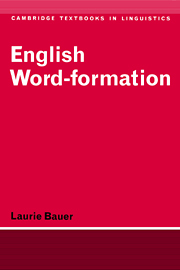Book contents
- Frontmatter
- Contents
- Dedication
- Preface
- 1 Introduction
- 2 Some basic concepts
- 3 Lexicalization
- 4 Productivity
- 5 Phonological issues in word-formation
- 6 Syntactic and semantic issues in word-formation
- 7 An outline of English word-formation
- 8 Theory and practice
- 9 Conclusion
- Bibliography and citation index
- Index
5 - Phonological issues in word-formation
Published online by Cambridge University Press: 05 June 2012
- Frontmatter
- Contents
- Dedication
- Preface
- 1 Introduction
- 2 Some basic concepts
- 3 Lexicalization
- 4 Productivity
- 5 Phonological issues in word-formation
- 6 Syntactic and semantic issues in word-formation
- 7 An outline of English word-formation
- 8 Theory and practice
- 9 Conclusion
- Bibliography and citation index
- Index
Summary
Natural phonology, but unnatural morphology.
(Skousen, 1974: 327)Introduction
Although many of the examples used in the preceding chapters have been taken from English, the points made have had a much wider application, as has been shown by the number of examples from other languages. In this chapter, and the rest of the book, attention will be concentrated far more upon English, and examples from other languages will be correspondingly rarer. With respect to phonology, this has some quite important implications. English is a relatively complex language phonologically speaking, with a large number of phonemes, and a large amount of phonological variation and alternation. As a result, the problems that will be discussed with relation to English may not occur in other languages. For example, in §5.2 the stress patterns on compounds like peanut butter (‘–’– Or‘—-) will be discussed. I know of no other language where precisely this problem is relevant. In French, for example, stress is always predictable over the phonological phrase, so that the problems discussed in §5.2, and also those discussed in §5.3, just do not occur in French. In Danish and German stress assignment in compounds is also relatively straightforward, although it is suggested in Bauer (1978b) that there are corresponding morphological difficulties in those languages, concerned with the form of the linking element (the -s- in Danish moder · s · mål ‘mother tongue’ from moder + mål; the -en- in German Tief · en · struktur ‘deep structure’ from tief + Struktur).
- Type
- Chapter
- Information
- English Word-Formation , pp. 101 - 139Publisher: Cambridge University PressPrint publication year: 1983

